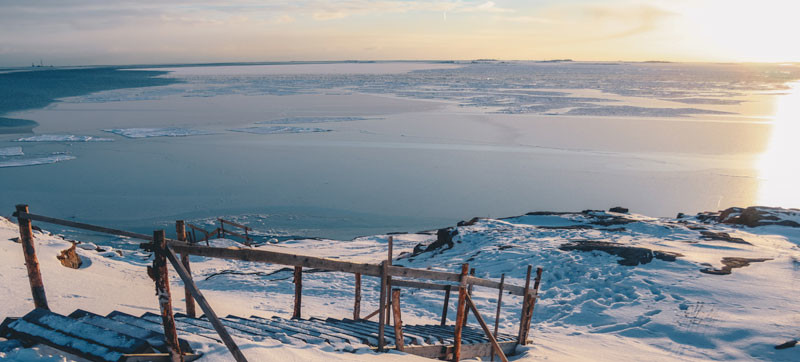The Arctic, China, and the Blue Economic Passage
At the meeting of the Arctic Circle, the association of governments, non-governmental organizations, academic institutions, and civil society groups with interest in the Arctic, the ever-increasing presence of China continued to affirm the renewed geopolitical competition in the region, further amplified by the accelerating impacts of climate change and the melting of the circumpolar sea ice. Heretofore the Arctic, if anyone considered it all, was preemptively the concerns of the eight nations with direct Arctic access, a western focus, the east being excluded by natural barriers and focus elsewhere. China made its first important foray into this dialogue in 2013 when it was recognized as an Arctic “observer,” in 2016 when it announced a formal initiative, The Polar Silk Road, a strategic element of its larger Road and Belt Initiative, a declared strategy to assert it economic power from Asia into Europe by road, train, and shipping systems to accommodate expansion of Chinese production and trade, and in 2018 with the publication of an Arctic “white paper,” a major policy statement of justification and specific action.
The unique marine and terrestrial ecosystems of the Arctic are now very much more available, economic value enhanced by depletion elsewhere, new technologies, climate realities, and national aspiration. The prize as valued by ecosystem service analysis has been estimated at some $281 billion a year in terms of food, mineral extraction, oil production, tourism, hunting, existing value and climate regulation in a 2017 assessment. It is a shocking figure, filled with implication for the regional environment, the local communities, and economic development opportunities in the future. It is an inevitable locus for Chinese interest and investment. With the opening of the Northern Sea Route, more direct connection with its land links and target markets is reduced in time and space with financial advantage through a circum-enclosure of Europe and increased access to the US and Canadian North Atlantic.
The “white paper” makes for interesting reading. It offers a list of the highest intentions, acknowledges existing national claim and international agreements, projects continuing serious investment in exploration and scientific study, and commits to cooperative bi-lateral treaties for specific intents, policy coordination, infrastructure connectivity, unimpeded trade, financial integration, what it calls “ blue economic passage” between China and Arctic states on almost every aspect of future development. The tone is responsible and collaborative; the rights of Nature and indigenous people are solemnly affirmed; and the sense of peace and harmony for these interactions assured. It appears progressive, reasonable, and inevitable.
To my view, the Chinese claim seemed overtly preemptive. The logic of their presence and influence goes against the certainties of the past, but they had expanded “observer” status almost to full and equal rights by simply being there. Further, in the list of Policies and Positions, below the blandishments and commitment to exploration, environmental protection, and cultural understanding, there was a key section on “Utilizing Arctic Resources” with several very specific implications:
1) Development of the Arctic Shipping Lanes
Calling for rights of use and freedom of navigation, a role in the establishment of security and logistical capacities, and infrastructure construction and operation of Arctic routes;
2) Exploration and Exploitation of Oil, Gas, Mineral and Other Non-Living Resources
Calling for participation in development of these resources through cooperation and forms of agreement; and participation and exchange in the study of clean energy sources such as low carbon technology, wind, and geothermal technologies.
3) Conservation and Utilization of Fisheries and Other Living Resources
Calling for access to the new fishing grounds of the future within the context of conservation and international agreements pertaining equally to all states; and access to the study and protection of marine genetic resources and the equitable sharing and use of the benefits of this exploitation.
The penultimate commitment pledges to the principles of “extensive consultation, joint contribution and shared benefits, emphasized policy coordination, infrastructure connectivity, unimpeded trade, financial integration, and closer people-to-people ties.”
In other words, a full seat at the Arctic table, like it or not.
The compelling interest in the natural wealth of the Arctic is not new news; it has been an underlying sub-text in all the prior meetings of the Arctic Circle, noble commitments to biodiversity, sustainability, indigenous communities, and traditional culture notwithstanding. What is interesting now is the arrival of a bumptious new player — with equal interest, advanced technology, more capital, autocratic decision-making, and fulsome determination. As genteel as it was all made to sound, it was a claim to power, pure and simple.

PETER NEILL is founder and director of the World Ocean Observatory and is author of The Once and Future Ocean: Notes Toward a New Hydraulic Society. He is also the host of World Ocean Radio, a weekly podcast addressing ocean issues, upon which this blog is inspired.
- Login to post comments
-



